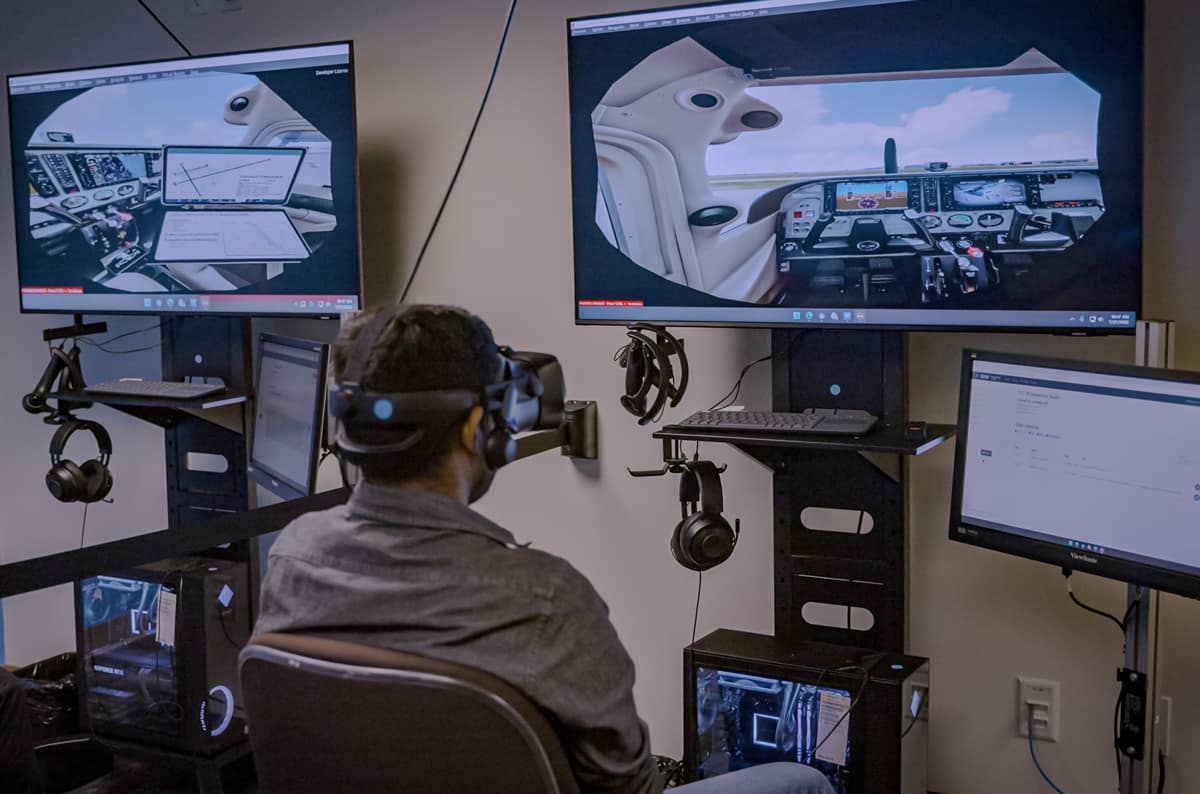Aviation Week Op-Ed: AI Can Help Flight Students Reach New Heights, Says Embry-Riddle President

In his latest Aviation Week essay, Embry-Riddle Aeronautical University President P. Barry Butler, Ph.D., writes about how revolutionary artificial intelligence (AI) technology is being used to teach flight students to communicate with air traffic control and other pilots before they ever step into an aircraft. Through the Hunt Library, the Eagle community can log onto ERNIE to freely access the op-ed. Alternatively, subscribers to Aviation Week can log on here to access the essay, which is also provided below.
As artificial intelligence technology takes off, it is natural to ask how AI might be employed in pilot training.
One area where AI can enhance current practices is in learning pilot-to-pilot and pilot-to-air-traffic-control (ATC) communications — everyday activities critical to aviation safety.
Teaching pilot communication skills has followed a timeworn path: an abundance of repetition and practice in the cockpit or in simulators. This poses a challenge for instructors, who are unable to stop and review each communication to provide corrective feedback mid-flight. Students also face the stress of live training flights, when they must suddenly navigate real-time, rapid-fire radio communications among multiple parties.
Embry-Riddle Aeronautical University is immersed in comprehensive methods for using AI to teach students standard phraseology before they start to fly, without instructor role-play and in a way that provides active assessment and better clarity.
AI’s automatic speech recognition, speech-to-text generation and natural language processing capacities allow for the interpretation of human speech and the response to it, as well as the ability to give corrective feedback — all in real time. “Without that, all you have is this very passive environment for independent practice,” said Aviation English Coordinator Andrew Schneider.
Two systems provided by our industry partner Advanced Simulation Technology inc. (ASTi) now form the basis of AI-driven ATC communications training at Embry-Riddle. The ASTi systems have been tailored to mimic the planes, airspace and flight scenarios that students encounter, including the busy traffic at Florida’s Daytona Beach International Airport.
Students begin in a virtual reality (VR) setup, receiving radio communication lessons from an instructor during a 360-degree flight video. They then review the communications with ASTi’s Pilot Phraseology Trainer, a platform that narrows the focus of radio calls.
The trainer shows students images of instruments, flight diagrams and 3D models. Using headsets, students listen to ATC and respond to the various prompts and visuals. AI technology interprets their responses and highlights errors. Each response is also scored based on pronunciation and structure, as well as adherence to FAA communication standards. Students practice the radio calls step-by-step and at their own pace by interacting with the AI.
Students then proceed to a system that fuses a customized VR flight trainer with ASTi’s Simulated Environment for Realistic ATC (SERA). SERA uses machine learning to create a dynamic environment filled with simulated air traffic controllers and radio communications from other aircraft. The controllers can give instructions — on position, altitude and route, for example — and respond to students’ requests, querying them when communications are not understood, just as real-life controllers would do.
First-year Aeronautical Science students spend nine hours on radio communications as part of a front-loaded, four-week immersive flight training program, which also includes learning preflight, checklist and flight procedures in VR environments.
Dr. Ken Byrnes, chair of the Flight Department at the Daytona Beach Campus, said that the time it takes for students to become proficient in radio communications has been substantially reduced since the program started. What’s more, he said, there is “significant improvement in their communications performance from their first flight, because we’ve spent so many hours focusing on it in a non-threatening environment.”
Schneider, who designed the ATC course, is developing the next step in ATC education, employing speech recognition and natural language processing tools on live flights. The leap forward will be to go beyond communications training and to apply AI technology to the massive, complex datasets collected at Embry-Riddle, which counts some 1,400 active flight students at any time.
An AI tool — trained on data from novice and expert pilots — could help detect flight skill mastery, said Dr. Tom Schnell, director of the University of Iowa’s Operator Performance Laboratory (OPL). Using performance data from simulated or live flights, this tool could create scenarios and lessons that reinforce training in areas where the student is weaker, acting as a “companion system” for the flight instructor, Schnell said.
During tours of Embry-Riddle’s immersion lab, visitors are often impressed by students in headsets running through checklists, moving flaps and flying. What is just as astounding, though, is to hear them — and to realize that these students are communicating throughout an entire flight without ever having stepped into one of our aircraft.
P. Barry Butler is president of Embry-Riddle Aeronautical University.
